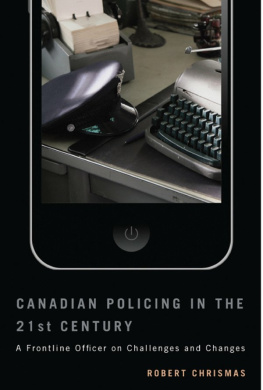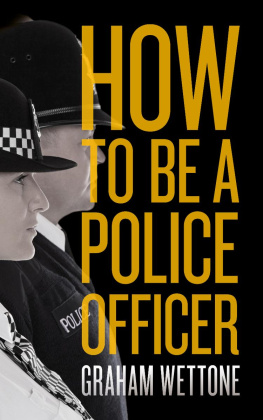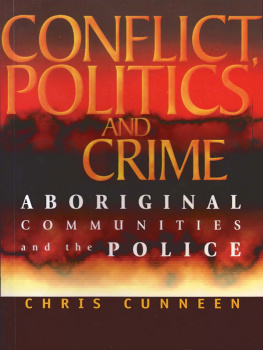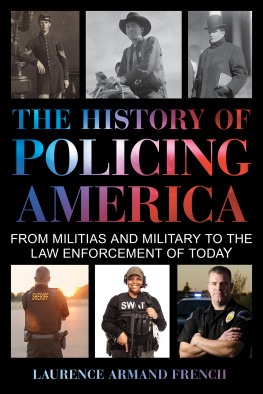The Use and Abuse of Police Power in America
Historical Milestones and Current Controversies
GINA ROBERTIELLO, EDITOR

Copyright 2017 by ABC-CLIO, LLC
All rights reserved. No part of this publication may be reproduced, stored in a retrieval system, or transmitted, in any form or by any means, electronic, mechanical, photocopying, recording, or otherwise, except for the inclusion of brief quotations in a review, without prior permission in writing from the publisher.
Library of Congress Cataloging-in-Publication Data
Names: Robertiello, Gina, editor.
Title: The use and abuse of police power in America : historical milestones and current controversies / Gina Robertiello, editor.
Description: First edition. | Santa Barbara, California : ABC-CLIO, an Imprint of ABC-CLIO, LLC, [2017] | Includes index.
Identifiers: LCCN 2016052099 | ISBN 9781440843723 (acid-free paper) | ISBN 9781440843730 (ebook)
Subjects: LCSH: Law enforcementUnited StatesHistory. | PoliceUnited StatesHistory.
Classification: LCC HV7921 .U84 2017 | DDC 363.2/30973dc23
LC record available at https://lccn.loc.gov/2016052099
ISBN: 978-1-4408-4372-3
EISBN: 978-1-4408-4373-0
212019181712345
This book is also available as an eBook.
ABC-CLIO
An Imprint of ABC-CLIO, LLC
ABC-CLIO, LLC
130 Cremona Drive, P.O. Box 1911
Santa Barbara, California 93116-1911
www.abc-clio.com
This book is printed on acid-free paper 
Manufactured in the United States of America
Contents
Preface
This reference book represents the culmination of centuries of events that have occurred in early America from the 17th century to the present. Since then, many critical incidents have occurred, leading to the need to address the police and the community. This encyclopedia was prepared to provide readers with an easy-to-use, accurate, up-to-date guide to the controversial past and current controversies facing our society in regard to relationships between the police and the public. It is presented as a quick reference to the chain of events, technological advances, changes in the law, and precedent-setting cases, confrontations, mandates, and debates that have affected perceptions of the police today.
The encyclopedia provides a unique approach to presenting the historical milestones that have affected police-community relationships. It allows the reader to develop a sense of the climate over time, in a clear, concise, and neutral mannerallowing them to increase their knowledge of previous and current events that have affected the way law enforcement carries out its public safety mandates. In addition, the focus on important and newsworthy situations allows undergraduates, graduate students, educators, and laypersons to better grasp the effects these incidents have had on the United States. By focusing on Blacks in conflict with the police, readers are able to evaluate the interactions between the police and the public, and the resulting influences that court cases, laws, encounters (often recorded), and the media have had on those perceptions. They are also able to more clearly identify why certain members of a community might have expectations that encounters with the police are going to end negatively. Those expectations might also affect their attitudes and reactions.
Each entry highlights the effects of historical events and social factors, as well as the influence of the media, in swaying public opinion and law-enforcement response. The value of the encyclopedia as a reference tool lies in the short essays that form the basis of more intensive investigationsa starting point for further research. The selection of topics was based on the most important and pressing issues that faced society in the past and that have shaped our views today. The people, cases, incidents, and events included in the encyclopedia are only a part of the many important factors that are worth examining in an effort to truly understand police-citizen relationships. The topics chosen for inclusion represent a diverse set of perspectives that affect the sentiment of minorities and non-minorities, law enforcement and citizens, as well as liberals and conservatives.
The task of researching these historical milestones is complicated by the conflicting opinions of members of law enforcement in comparison to the opinions of community members. There is a lack of a consensus on what constitutes fair and just treatment of minorities, and the subject generates debates, tensions, and numerous conflicts between the two groups, as well as within the community and among law enforcement officers. Each of the entries includes events and conflicts that shape our culture, perceptions, views, and actions. Attention to factual content and objectivity have been maintained, though it may be impossible to eliminate all unconfirmed information. The editor and authors apologize in advance for any unintentional inclusion of information gathered from sources that may not be reliable.
Topics include historical data on legal and societal limits to police power in early Americaimportant amendments, policing of the pastto technological advances and the rise of organized crime. Specific cases are mentioned, as well as influential persons (Sir Robert Peel, Teddy Roosevelt, and William Bratton, to name a few). Next, law enforcement in the time of the political and social upheaval, and the reactions to that time, are covered (the Kerner Commission), and other important cases that set precedents for future cases ( Miranda v. Arizona , Terry v. Ohio , Mapp v. Ohio ) to give readers a perspective of the sentiment at the time. Readers will then learn of new mandates for exercising police power (Wilson and Kellings Broken Windows Theory, the Rodney King beatings, Ruby Ridge). Finally, readers will be able to peruse essays on the intensifying debate about the American Police State, including information from the year 2000 to the present. Racial profiling, police mistreatment of the public, and certain well-known cases are discussed.
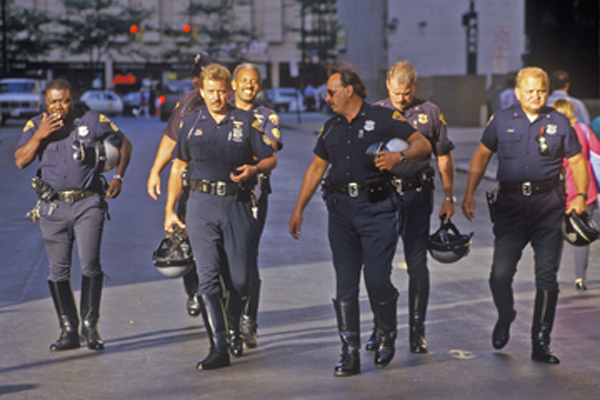
Police officers are assigned to respond to calls for assistance by foot patrol and by motorized patrol, with the goal of protecting the public. They are contracted to enforce the law, make arrests, issue tickets, and reduce fear of crime. (Americanspirit/Dreamstime.com)
In particular, cases that have received recent media attention and those that have led the public to question police motives (Michael Brown, Trayvon Martin, Tamir Rice, Sandra Bland, Freddie Gray, and Eric Garner) are summarized. Additionally, variations in law enforcement attitudes about gun control, dash-cam videos, and body cameras, for example, are reviewed and examined. By looking at the different situations, readers can draw their own conclusions.
The process for choosing which material to include in the publication is a complex evolution of research and the application of the inclusion criteria. The groups included in this encyclopedia therefore represent only 80 of the major turning points, and many more could be examined in the future. The encyclopedia does contain a number of cases that, at the time of this writing, had still not been settled, had not gone to trial yet, and for which indictments had yet to be issued. However, as they met the criteria (controversial issues), they were included. These cases will need to be revisited and follow-up writings will be necessary.
Next page

